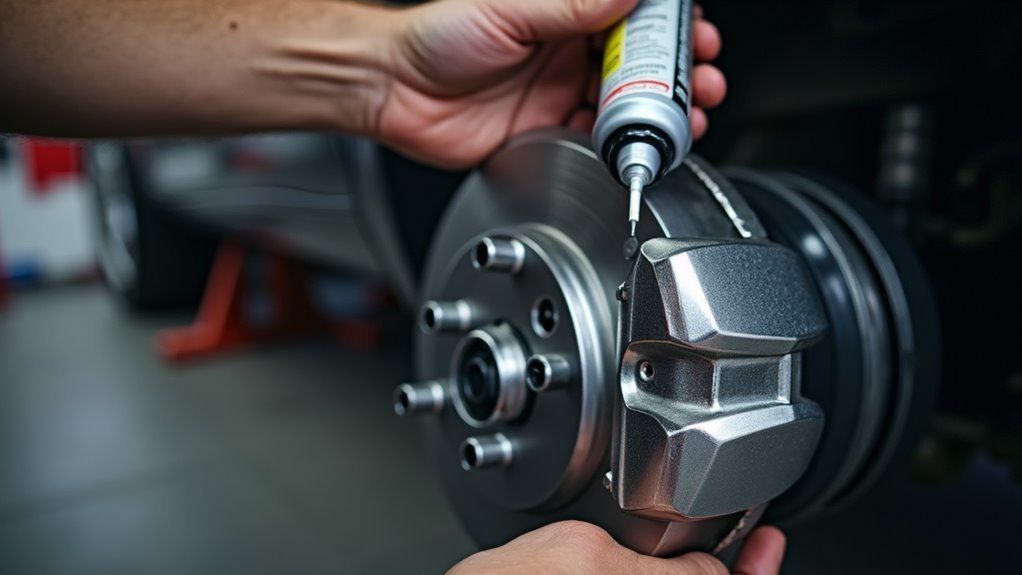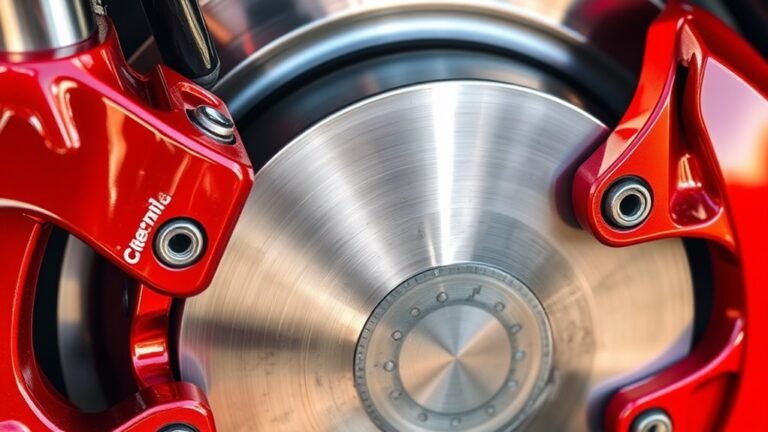When you’re servicing brake pads, knowing where to apply grease is vital for excellent performance. Use a ceramic-based or silicone lubricant on key areas like the backing plate contact points and caliper guide pins. Don’t skip the mounting tabs or anti-rattle clips either. Proper lubrication cuts noise and prevents corrosion, but there’s more to it. Stick around to uncover the precise spots that guarantee quiet, efficient braking.
key Takeaways
- Apply grease to backing plate contact points where they meet caliper pistons for smooth operation.
- Lubricate shim-to-pad interfaces sparingly to reduce noise and protect friction material.
- Coat mounting tabs and slide channels with grease to prevent rust and ensure even wear.
- Use grease on anti-rattle clips and hardware edges to minimize vibration and noise.
- Avoid greasing between brake pad surfaces and friction material to maintain braking efficiency.
Essential Areas for Brake Pad Lubrication
While maintaining your vehicle’s braking system, it’s critical to focus on lubricating the essential areas of brake pads to safeguard ideal performance and durability. Start by applying a thin layer of ceramic-based or approved silicone grease to the backing plate contact points where they meet caliper pistons. This secures edge protection against wear and corrosion.
Next, lubricate the shim-to-pad interfaces and bare pad surfaces sparingly to reduce noise and provide friction material protection from premature degradation. Don’t forget the mounting tabs—coat their slide channels with grease for rust prevention and even wear. Finally, apply a light coating to anti-rattle clips and contact edges of hardware. This minimizes vibration and noise, extending component life with precise, targeted lubrication. Proper brake lubrication is vital to ensure smooth operation and prevent issues with brake system components. Remember that lithium-based greases are specifically designed to withstand the extreme temperatures generated during braking. For optimal safety, avoid applying lubricant between brake pad surfaces and noise suppression shims.
Caliper Guide Pins and Bushings
Diving into the maintenance of caliper guide pins and bushings, you’ll find that proper lubrication is critical to guarantee smooth operation and prevent uneven brake pad wear. Without it, pins can seize, causing accelerated wear and poor braking performance. Use silicone-based grease for its heat tolerance and compatibility with rubber dust boots, ensuring anti wear characteristics and long term durability. For optimal results, avoid using petroleum based lubricants which can deteriorate rubber components and lead to caliper pin failure.
Operating in extreme temperature ranges from -40°C to 220°C, silicone-based lubricants provide reliable protection across all weather conditions. Start by thoroughly cleaning the pins, removing old grease and debris. Apply a sufficient layer of grease directly to the pin before reinserting it into the caliper bracket bores, guaranteeing full coverage. Check compatibility with rubber or plastic bushings to avoid damage. Regular lubrication and inspection keep everything sliding smoothly, preventing costly issues down the road. Dielectric silicone grease is particularly effective in preventing stuck pins, which can lead to uneven brake wear.
Caliper Piston Contact Points
As you maintain your brake system, pay close attention to the caliper piston contact points, where proper lubrication is essential for ideal performance. Apply a thin layer of silicone-based grease to the piston faces to guarantee smooth retraction and even pad wear. Lightly coat the piston sliding surfaces to prevent corrosion, but don’t overdo it—excess attracts debris. Damaged piston boots can lead to severe corrosion that seizes brake calipers.
Be cautious around piston boot seals and seal contact surfaces; avoid greasing directly on or behind them unless specified, as it risks contaminating brake fluid. Use a brush for precision on the back of bare pads to reduce noise, keeping grease away from friction material. During pad replacements, re-grease these areas to sustain quiet, efficient braking and protect hydraulic integrity. Additionally, before compressing the piston, ensure it is properly lubricated to extend boot life. The forged steel housing provides durability against heat and friction during braking operations.
Brake Pad Mounting Tabs and Edges
Pay close attention to the brake pad mounting tabs and edges when maintaining your brake system, as these critical areas require proper lubrication for ideal performance. Apply a thin layer of silicone-based lubricant, like Super Lube or PowerStop, to the mounting tabs and pad edges to prevent brake pad sticking and guarantee smooth movement within the caliper. This reduces friction, minimizes noise, and prevents corrosion, extending pad life. Installing brake pad clips helps maintain secure positioning and proper alignment of the pads within the caliper assembly.
Focus on precise application to avoid excess grease, which can interfere with pad clearance adjustment. Lubricate only the contact points and edges, never the friction surface, to maintain braking efficiency. Regularly inspect these areas for wear, as proper lubrication ensures even wear distribution and optimized heat management during operation. Additionally, proper lubrication of these components ensures noise-free braking as it minimizes unwanted vibrations during brake application. Using brake-specific lubricants is essential since they’re specially formulated to handle the high temperatures generated during braking.
Retaining Clips and Anti-Rattle Springs
How often do you inspect the retaining clips and anti-rattle springs in your brake system? Your clip inspection frequency should align with every pad replacement or tire rotation to catch cracks, deformation, or corrosion early. These components prevent pad vibration and noise, so don’t skip replacing them if they’ve lost tension or show rust pitting. Brake pad clips help maintain consistent stopping power by keeping pads properly positioned within the calipers. Anti-squeal design helps maintain a small gap between brake pads and rotors during normal operation.
When installing new clips, clean the caliper bracket grooves thoroughly and apply high-temperature brake grease to clip-to-caliper contact points to reduce friction. For spring corrosion prevention, lightly lubricate the ends to avoid rust stiffness, but never grease areas near the rotor or pad backing. Verify clips move freely post-installation. Using OEM clips guarantees proper fit, protecting your rotors from damage due to misalignment. Proper installation of these clips ensures safe braking and prevents potential issues down the road.
Pad Shims and Caliper Body Contact
While maintaining your brake system, don’t overlook the critical role of pad shims and their interaction with the caliper body. You’ve gotta apply grease precisely to ascertain smooth operation and reduce noise. Focus on lubricating the caliper bracket contact points where shim edges slide, ensuring proper shim to caliper bracket alignment. Use silicone-based grease sparingly—about a 10mm diameter spot—to prevent migration to friction surfaces. Also, maintain shim to backing plate clearance by applying a thin layer of manufacturer-recommended grease between the shim and backing plate, avoiding over-application near friction material. Clean all surfaces before greasing to avoid contaminants. Prioritize high-friction zones like guide pins and bushings, enabling seamless shim movement during braking without attracting debris. Greasing these areas is essential to prevent squeaking and ensure proper brake pad movement prevent squeaking noise. The synthetic formula lubricant provides exceptional water resistance while maintaining adhesion in adverse conditions. Prioritize high-friction zones like guide pins and bushings, enabling seamless shim movement during braking without attracting debris. High temperature resistance is crucial since standard lubricants can melt and compromise brake performance.
Backing Plate and Piston Interaction Zones
Dive into maintaining the backing plate and piston interaction zones, focus on the critical contact points where noise and vibration can originate. Start by degreasing the piston and caliper surfaces with brake cleaner, ensuring no residue interferes with bonding. Apply a thin, uniform layer of anaerobic adhesive, chosen for its temperature resistance of adhesive exceeding 300°C to handle braking heat. Don’t over-apply; excess can contaminate crucial components. After installation, perform initial bedding-in with moderate stops to kickstart the adhesive curing process, allowing it to harden under pressure. Test for drag by rotating the wheel manually, and monitor for noise over the first 50 miles. Retorque hardware later to account for thermal cycling and compression. Additionally, ensure that the adhesive effectively bonds the pad to the piston or caliper to shift resonant frequency. Remember to avoid using anti-seize compounds on brake pads as they can attract dirt and compromise brake performance. Silicone-based lubricants are essential for protecting slide pins and caliper bracket bores from corrosion and wear.
Rear Parking Brake Mechanisms
Dive into the intricacies of rear parking brake mechanisms to guarantee reliable operation and prevent common failures. As you inspect the system, focus on the cable splitter mechanism adjustments at the junction where the single cable divides to the rear wheels. Ascertain these are free of corrosion and properly tensioned to avoid uneven braking. Like control arm bushings, these components play a vital role in maintaining vehicle stability and safety.
Next, prioritize pivot point lubrication where cables connect to lever arms or equalizers. Apply a thin layer of silicone-based grease to these metal-on-metal zones to reduce friction and prevent seizing. For optimal protection, use a synthetic brake grease that includes molybdenum disulfide and PTFE additives. Don’t overlook the equalizer bar and cable guide tubes, as they’re prone to sticking from road salt. With precise care, you’ll maintain smooth actuation and extend the lifespan of these critical components. Additionally, ensure the parking brake cable is securely connected to the brake assembly for optimal performance securely connected cable.
Key Tips for Proper Grease Application
Immerse yourself in the essentials of proper grease application for brake pads to guarantee peak performance and safety. Start with a grease compatibility assessment—ensure the lubricant suits rubber seals and metal components, opting for synthetic or silicone-based options where needed. Apply a thin, pea-sized layer to caliper slide pins, pad edges, and abutment clips using a precision brush, avoiding friction surfaces like pad linings.
For noise reduction techniques, grease metal contact points and verify pads slide freely in brackets. Clean surfaces before application, and don’t use petroleum sprays like WD-40. Reassemble to torque specs, wipe excess with brake cleaner, and test brake function. Check that tension tab alignment matches the bracket’s top and bottom notches for optimal performance. Inspect regularly for dried grease, ensuring consistent operation under high heat with rated lubricants. Remember that proper lubrication is essential to prevent dangerous brake failures and ensure smooth system operation.




